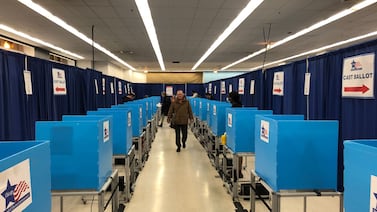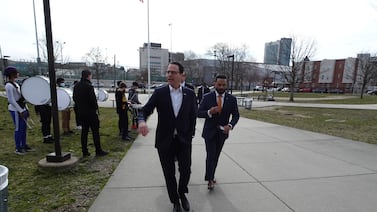Sign up for Chalkbeat Indiana’s free daily newsletter to keep up with Indianapolis Public Schools, Marion County’s township districts, and statewide education news.
A reading intervention once hailed as a “phenomenal success” for Indiana’s first graders may be one of the first phased out from schools this year as the state pushes to align elementary literacy instruction with the science of reading.
Reading Recovery, an intervention which pairs first graders with trained teachers for 30 minutes of one-on-one reading help each week, was used to instruct thousands of Indiana students beginning in the 1990s and found champions at Purdue University.
But its status going forward is murky as Indiana joins other states in banning one of its core teaching methods, known as three-cueing. The program has already met skepticism in its home state of Ohio, which has also banned the practice.
Mirroring the “reading wars” that are causing districts nationwide to rethink literacy instruction, educators in Indiana disagree over whether there’s a place for the program in Indiana schools. One district says it will add science of reading-focused training in addition to existing Reading Recovery programs.
The final call will come from the Indiana Department of Education, which is in the midst of a curricular review process to create a list of approved materials.
Education leaders are hoping for clarity in the guidance and flexibility to make local decisions as they prepare to adopt new curriculum and retrain their staff. It’s a potentially contentious process after decades of highly charged opinions about — and experience with — reading instruction.
“You’re training on three levels — beliefs, knowledge, and skill. It’s a lot simpler to help people develop new skills, rather than change what they believe,” said Anne Olson, curriculum director at Wayne schools.
Meanwhile, researchers say it’s critical for schools and teachers to quickly get on board with programs based in the science of how people learn to read as Indiana faces stagnating literacy rates. What makes today’s push for literacy different is its grounding in decades-old brain science research, said Karen Betz, assistant professor of literacy at Marian University in Indianapolis.
“The problem with education is that we tend to get on bandwagons,” Betz said. “The science of reading isn’t a bandwagon.”
The beginning and end of Reading Recovery
Reading Recovery is based in part on the three-cueing model that asks students to infer words based on context clues — a teaching method now banned in Indiana. The program came to the U.S. from New Zealand in the 1980s, with a base at Ohio State University. (The Reading Recovery Council of North America did not return a request for an interview.)
Betz, who taught in Ohio schools for 18 years, said Reading Recovery was one of the first one-on-one interventions at a time when teachers were teaching primarily to the whole class. Research on reading science had yet to percolate into classrooms, she said, and many teachers were grateful for any extra help for their struggling readers.
“If it sounded like how you might teach reading, we gravitated towards it,” Betz said.
In practice, the program gave children texts that weren’t decodable, she said. It asked them to memorize sight words and figure out other words based on pictures on the page, rather than focus on sounding out the word in front of them.
“I wouldn’t give them a text that says ‘see’ if they didn’t know ‘ee’ for example,” she said of an approach grounded in the science of reading.
Still, studies throughout the years showed that the program improved reading test scores in the short term. In Indiana, Purdue University’s Center for Literacy Education and Research became a training center for Reading Recovery, and the program reached 24,000 children in 166 of around 400 school districts in Indiana by 2000, according to a Purdue News Service article.
But the program’s ascent masked issues.
For one, Reading Recovery was expensive, said Aaron Churchill, Ohio research director for the Thomas B. Fordham Institute, a conservative think tank, because it relied on individual tutoring. Many programs in Indiana ended in the early 2000s after state and federal funding dried up.
Over time, experts also found evidence that its benefits didn’t last long. In 2022, research showed that the boost in student performance measured among first graders who participated in Reading Recovery faded by third and fourth grade. In fact, students who were enrolled in Reading Recovery performed worse than those who never received the program.
“The theory is that students were not building the background in decoding and phonics,” Churchill said. “The skills from Reading Recovery were not sticking.”
This year, both Ohio and Indiana joined an aggressive nationwide push to teach reading through research-backed methods known as the science of reading, which relies on five pillars of literacy instruction: phonemic awareness, phonics, fluency, vocabulary, and comprehension. A new Indiana law, enacted this year, gives schools until the 2024-25 school year to adopt curriculum aligned with those teaching methods, and bans methods based on three-cueing.
That raises questions about the intervention in Indiana districts that still use it, like Vigo schools — the 10th largest district in Indiana — where teachers have used the intervention with over 5,000 students over two decades.
In response to questions from Chalkbeat, representatives said the district will be adding training that’s aligned with the science of reading in addition to Reading Recovery.
“New materials and strategies will be implemented as our Title I teachers continue to focus support on our early reading interventions in the coming years. We look forward to seeing even greater gains as we develop stronger reading skills yielding success all the way to greater graduation rates,” a statement said.
The district employs 25 Title I/Reading Recovery teachers who provide the intervention to first graders, as well as other interventions in older grades. Their salaries are paid with Title I grant money.
The program has been well-received: In 2019, the Vigo County school board recognized Reading Recovery teachers, and in the same year, the district linked Reading Recovery to its higher-than-average literacy scores as measured by the state’s IREAD test for third graders.
Around 91% of Vigo’s third graders tested proficient in reading in 2019. But like in many other districts, scores dropped after the pandemic to as low as 81% in 2022, before a slight recovery this year to 84%.
It’s not clear how many other districts use Reading Recovery or similar interventions — the state department of education does not collect information on local curriculum. Betz, the Marian University professor, said it’s more common in Indiana schools to find Fountas and Pinnell’s Leveled Literacy Intervention, which has faced similar criticisms for teaching cueing. (Representatives of Fountas and Pinnell also did not respond to a request for comment.)
A Purdue representative said the university ended its affiliation with Reading Recovery in 2013.
The university has recently relaunched its literacy center to also focus on the English language, said the center’s director, Christy Wessel-Powell.
It’s one of the state’s colleges using a grant from the Lilly Endowment to align its courses and professional development to the science of reading, Wessel-Powell said.
‘The key is teacher autonomy’
What exactly comes next — and whether Reading Recovery has a future in schools — is still being debated.
The Indiana Department of Education said the list of recommended reading curriculum that it’s required to compile by the new state law is not yet available.
Reading Recovery has evolved from its inception, said Karen Wohlwend, professor of Literacy, Culture, and Language Education at Indiana University, adding that many reading specialists incorporate phonics and word recognition in their daily lessons.
“There is no simple formula for reading instruction, no one-size-fits-all approach. It takes a skilled and responsive teacher (the heart of RR) who can teach strategies matched to learners’ unique needs,” Wohlwend said.
Wessel-Powell of Purdue said educators have long agreed on the importance of the science of reading’s five key elements, although the names of the programs and emphasis on each skill has changed over the years.
But one-on-one or small group models — like the kind used in Reading Recovery — that incorporate the science of reading can still offer important support to students, she said.
“The thing I would hate as a researcher to see is decision-making taken away from teachers, to limit the options they have for what programs they can use,” she said. “No one program gives kids everything they need. The key is teacher autonomy and the ability to have a variety of tools.”
Wayne Township schools never adopted Reading Recovery wholesale. But Olson, the district’s curriculum director, said that a group of Reading Recovery trainers led small group interventions at the district in the early 2000s, and that this strategy led to progress in students’ reading scores.
Wayne began adopting phonics and phonemic awareness-based curriculum around 2019, which Olson said aligns well with the state’s new mandate. District teachers haven’t just studied the curriculum; they’ve also learned about the reasoning behind it through books, online courses, and other professional development.
“Our efforts have gone into helping people understand what’s happening in the brain as people learn to read,” she said. “It doesn’t stay in the world of theory, it moves into practical application.”
What’s needed next is clarity on the science of reading requirements from the state, she said, along with enough flexibility to meet the needs of students who might be multilingual, or from diverse cultural backgrounds, for example.
Betz said she hopes that under the new state law, teachers and schools get more funding and support to implement the programs that work.
“We know the science of not only reading, but the science of teaching reading,” Betz said. “You need to give teachers the tools to deliver the instruction, because you can’t wait any longer.”
If you are having trouble viewing this form, go here.
Aleksandra Appleton covers Indiana education policy and writes about K-12 schools across the state. Contact her at aappleton@chalkbeat.org.







